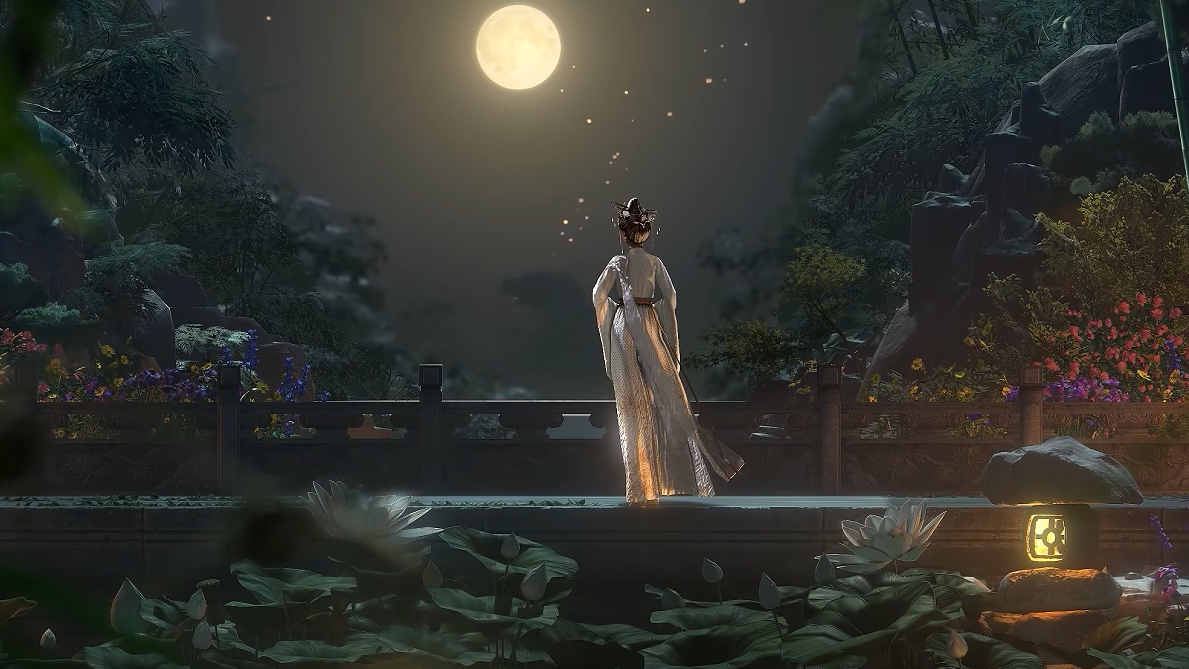Where Winds Meet quietly hides one of its most charming systems: you can stand in a town square and perform full songs on in-game instruments. Officially, that happens through a built-in rhythm minigame and musician NPCs. Unofficially, PC players are wiring in MIDI files, macro tools, and even external keyboards to turn those instruments into automated concert machines.
How music normally works in Where Winds Meet
The game’s music system is presented as a rhythm minigame. You find musician NPCs marked by instrument icons on the world map, walk up, and choose the music interaction option. That opens a multi-lane note chart at the bottom of the screen: notes fall from the top, each lane maps to a button, and you hit the right input when a note lands on its circle to keep the performance going.
Special musician NPCs called Graceful Melodies act as high‑value music challenges. Completing their songs can raise your Musicality stat and award Echo Jade, coins, experience, exploration progress, and new melodies that unlock additional tracks to play. These NPCs appear in early regions like Qinghe and continue to show up as you explore further, which encourages you to keep returning to music even if you primarily focus on combat or exploration.

The unofficial MIDI player many PC fans use
On PC, one specific Windows tool has become the go‑to option for automating instrument performances. Its folder name includes Chinese characters and a version string, for example:
游吟诗人Ver3.0.4\游吟诗人Ver3.0.4\The program’s role is simple: it reads a .mid file, translates notes into the game’s keybinds, and then sends those key presses to the game client in real time. Instead of manually playing the rhythm minigame, you trigger playback and let the tool press the keys.
Players highlight several key characteristics:
| Aspect | What the MIDI tool does |
|---|---|
| Platform | Windows PC, launched as a standalone executable. |
| Purpose | Play pre‑made MIDI files by simulating keyboard input in Where Winds Meet’s instrument mode. |
| Origin | Originally created for the Chinese version of the game; shared into the global PC community later. |
| Input type | Takes standard .mid files and maps them to in‑game notes. |
| Key layers | Supports modifier keys like Shift and Ctrl to access higher or lower octaves, matching the game’s controls. |
| Interface language | Chinese, with an included PDF screenshot configuration reference. |
Because the original download is distributed through a Chinese Baidu storage link, many players outside China struggle to create an account for direct access. Community members have responded by mirroring the installer elsewhere or sharing it privately. The developer’s own page is hosted at chrisfu.cn/archives/64/, but accessing the file there typically requires logging into Baidu first.
Basic setup: getting the MIDI tool to talk to the game
The MIDI player does not integrate through an official API. Instead, it works like a controlled macro: when you start a song in the program, it begins sending keyboard events that match your in‑game keybinds.
Players who have it working consistently tend to follow a similar setup pattern:
| Setup step | Practical detail |
|---|---|
| Run as administrator | Launching the MIDI program in admin mode makes key injection more reliable so the game actually registers inputs. |
| Match the PDF screenshot | The tool includes a PDF image of the intended settings; aligning every toggle with that reference is a common fix when keys appear to press but do nothing in-game. |
| Uncheck extra options | Users report success by disabling all optional settings in the configuration panel, leaving only the defaults required for playback. |
| Align keybinds | The game’s in‑instrument keybinds must match what the MIDI tool expects; otherwise, it will play the wrong notes or none at all. |
One frequent issue occurs when users can see the MIDI program “pressing” keys in its interface, but the game does not react. In those cases, launching it as admin and mirroring the PDF’s screenshot layout are the two fixes that come up again and again. When Shift or Ctrl‑based high and low notes fail, checking the keybinding mappings inside the tool is the next troubleshooting step.
Adding your own MIDI songs to the library
The program ships with a bundled library of songs, but it also supports manual imports. The folder structure reveals how it organizes these tracks.
| Folder path | Usage |
|---|---|
游吟诗人Ver3.0.4\游吟诗人Ver3.0.4\mid_lib |
Main library of standard .mid tracks accessible from the program’s song list. |
游吟诗人Ver3.0.4\游吟诗人Ver3.0.4\love_mid_lib |
“Favorite” or highlighted tracks shown in a separate section of the interface. |
To add new music, users copy .mid files into mid_lib or love_mid_lib and then select them from within the application. There is also a UI button next to the search bar that imports MIDI tracks directly; that button is the main way people add songs without digging through folders.
Not every MIDI file works perfectly. When files fail to import or crash the app, players typically remove those files, assuming they use unsupported formatting or too many channels for the tool’s parser. There is no in‑program error dialog that explains why a specific track fails, so trial and error is common.
Using real MIDI keyboards with Where Winds Meet
The Chinese MIDI player focuses on pre‑recorded files rather than live performance. Anyone hoping to sit at a physical piano or MIDI keyboard and play Where Winds Meet as an instrument needs extra routing software.
At least one player describes success by connecting a MIDI keyboard to the game through CoyoteMidi, a separate utility that converts MIDI note input into keyboard events. In that setup, the chain looks like this:
| Component | Role in the chain |
|---|---|
| MIDI keyboard | Generates live MIDI note messages when you press keys. |
| CoyoteMidi | Listens for those MIDI notes and maps them to keypresses that match the game’s instrument controls. |
| Where Winds Meet | Receives the resulting keypresses and plays notes on instruments like the guqin. |
That approach is very different from pressing play on a MIDI file; it effectively turns the game into a sound module controlled by your keyboard. Configuration details vary by user, but the core idea is the same: one program reads MIDI, translates it into the correct keys, and the game only ever sees normal keyboard input.
Common problems: key spam, crashes, and being kicked out of instruments
Automated performances introduce a set of issues that manual players rarely see. The most disruptive is being forced out of instrument mode mid‑song, sometimes followed by a flurry of unwanted menu clicks as the macro keeps firing keys.
Players identify a few triggers and workarounds:
| Issue | Observed behavior | Workaround or note |
|---|---|---|
| Randomly exiting instrument mode (multiplayer) | Performance stops after 30–60 seconds or longer; the character exits the instrument state. | Some players attribute this to other users using Meridian Touch to break animations; others note it can also occur with no one nearby, suggesting a game‑side instability. |
| Menus opening while a song plays | The game suddenly opens banners or other UI panels mid‑performance; macro continues pressing keys and “clicks around” in menus. | Disabling in‑game banners under Settings > Other reduces cases where keybinds like T trigger pop‑ups when someone likes the performance. |
| App crashing upon song selection | The MIDI tool closes every time a certain track is chosen. | Problem songs are usually removed or replaced; users treat it as a limitation in the player’s MIDI parsing. |
| Macro works in app but not in game | On‑screen indicators in the MIDI tool show keys being pressed, yet no sound or notes register in-game. | Running the MIDI tool as admin, mirroring the PDF settings, and unchecking extra configuration boxes are recurring fixes. |
Another quirk is performance length inconsistency. Some sessions run smoothly for more than ten minutes; others break after less than a minute. One small quality‑of‑life trick that players mention is minimizing or backgrounding the game window after a song starts. As long as no one interacts with the character and no system pop‑ups appear, long automated performances are more likely to complete uninterrupted.

Is using external MIDI and macro tools safe for your account?
There is no explicit in‑game toggle or policy menu that blesses or bans third‑party MIDI players. The unofficial tools discussed here do not modify game files; they send regular keyboard input, similar to how generic macro software behaves.
Community members who also play other MMOs report using similar MIDI macro utilities with no bans and assume the same will hold here, especially because the original Chinese MIDI player was developed for the game’s domestic client first. That said, using any external automation always carries some level of risk. Players who are cautious tend to keep their usage focused on music, avoid running other suspicious macros at the same time, and stay within behavior patterns that still look like performing songs, not botting core gameplay.
The more interesting trend is that the music community is not only importing tools but also talking about building new ones. At least one developer has considered coding a personal solution if large‑scale use of existing MIDI players remains frictionless. For now, though, the ecosystem revolves around the Chinese “游吟诗人” tool, community‑shared mirrors, and MIDI‑to‑key translators like CoyoteMidi for those who want to perform live.
If you enjoy the rhythm minigame on its own, it still works as intended: track the lanes, learn the timing, and hunt down Graceful Melodies NPCs for Musicality and rewards. But for players willing to tinker with third‑party software, Where Winds Meet’s instruments can become much more than a side activity—they turn into a stage where entire MIDI libraries and physical keyboards can feed into a wuxia concert.


